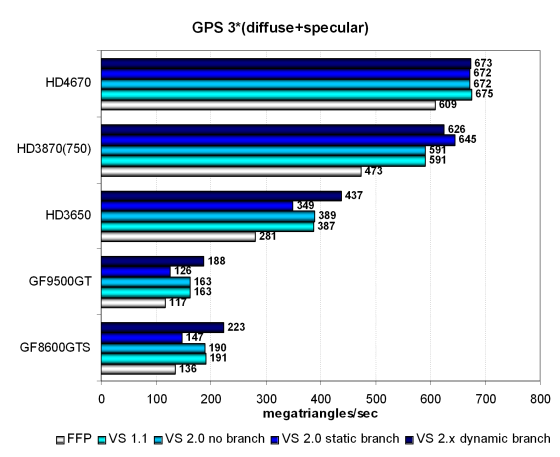Synthetic tests
Testbed
- Intel Core2 Extreme QX9650 (3000 MHz) CPU
- Zotac 790i Ultra motherboard on NVIDIA nForce 790i Ultra
- 2GB DDR3 SDRAM Corsair 2000MHz
- WD Caviar SE WD1600JD 160GB SATA hard drive
- Tagan TG900-BZ 900W PSU
- Windows Vista 32bit SP1, DirectX 10.1
- Dell 3007WFP 30-inch monitor
- ATI CATALYST 8.8; NVIDIA 177.79
- VSync disabled
Benchmarks
RightMark3D 2.0 requires MS Visual Studio 2005 runtime as well as the latest DirectX runtime update.
Compared graphics cards:
- RADEON HD 4670 with standard parameters (HD4670)
- RADEON HD 3870 at 750/1000 MHz (HD3870(750))
- RADEON HD 3650 with standard parameters (HD3650)
- NVIDIA GeForce 9500 GT with standard parameters (GF9500GT)
- NVIDIA GeForce 8600 GTS with standard parameters (GF8600GTS)
We selected these graphics cards to compare with the new RADEON HD 4670 for the following reasons: RADEON HD 3870 at 750/1000 MHz will help us evaluate the effect of improvements in the RV7xx architecture versus RV6xx, as well as performance differences between the generations. RADEON HD 3650 is the card to be replaced with AMD HD 4600. GeForce 9500 GT is one of the main competitors from NVIDIA, we can also mention GeForce 8600 GTS, which can be still found in stores. There is also another rival from NVIDIA -- GeForce 9600 GSO, but its presence is not mandatory in our synthetic tests.
Direct3D 9: Pixel Filling tests
This test determines peak texel rate in FFP mode for different numbers of textures applied to a pixel:
Everything is as usual -- many graphics cards do not reach results close to the theoretical maximum in our outdated test (we haven't got a replacement so far). Results of this synthetic test are most often a tad lower than the theoretical maximum. RADEON HD 3650 comes closer to this threshold than the other cards, its result almost matches the theoretical value. What concerns the other cards with better TMUs, both NVIDIA and new RV7xx cards, they fail to reach theoretical maximum in this test. It turns out that RV730 looks up fewer than 16 texels per cycle from 32-bit textures with bilinear filtering, much lower than theoretical values. Performance may be limited by video memory bandwidth.
But even this performance level is sufficient for RV730. It demonstrates even a tad higher results than RV670 operating at the same frequencies. We compare it with a GPU of a higher level here, even though of the previous generation with reduced frequency. If we compare with NVIDIA cards and the old HD 3650, HD 4670 is faster by 80-100%, almost twice as fast. In the test with one texture, HD 4670 is slightly outperformed only by HD 3870 owing to less efficient fill rate. But in case of more textures per pixel, ROPs reveal their full potential and the RV730-based card becomes even faster. Let's have a look at the fill rate results:

The second synthetic test measures the fill rate. It shows the same situation adjusted for the number of pixels written into the frame buffer. In case of 0 and 1 texture, RADEON HD 4670 performs on a par with GeForce 8600 GTS, which has similar memory bandwidth (performance is mostly limited by memory bandwidth in such modes). As in the previous test, the new card shoots forward in situations with lots of textures per pixel, performing on a par with HD 3870 with reduced frequencies.
Direct3D 9: Geometry Processing Speed Tests
Let's analyze a couple of stress geometry tests. The first test uses the simplest vertex shader that shows maximum triangle throughput:
All these GPUs are based on unified architectures, their unified processors in this test are busy with geometry processing only. So all solutions demonstrate high results, which are evidently limited not by peak performance of unified processors, but by performance of other units, for example, triangle setup.
That's what results show -- all AMD cards demonstrate similar results at similar frequencies. They are traditionally faster than any NVIDIA solutions here. Performance of RADEON HD 4670 in this test is little different from performance of other cards. This test depends solely on GPU clock rate. We proceed straight to the most complex geometry task with three light sources and static/dynamic branching:
In this case AMD and NVIDIA cards demonstrate a much more noticeable difference, the gap has grown several times. Interestingly, there has already appeared a difference between AMD cards here, even between HD 3870 and HD 4670 operating at the same frequencies. The new Low-End graphics card looks better, being limited in all modes by something like triangle setup, as its results changed little from the previous test. In this test the new graphics card from AMD is 4-6 times as fast as both GeForces.
Streaming processors certainly distinguish themselves in this case, the new GPU puts up excellent performance in geometry tests. What concerns real applications, unified processors are busy mostly with pixels there. We proceed to such tests now.
Write a comment below. No registration needed!




